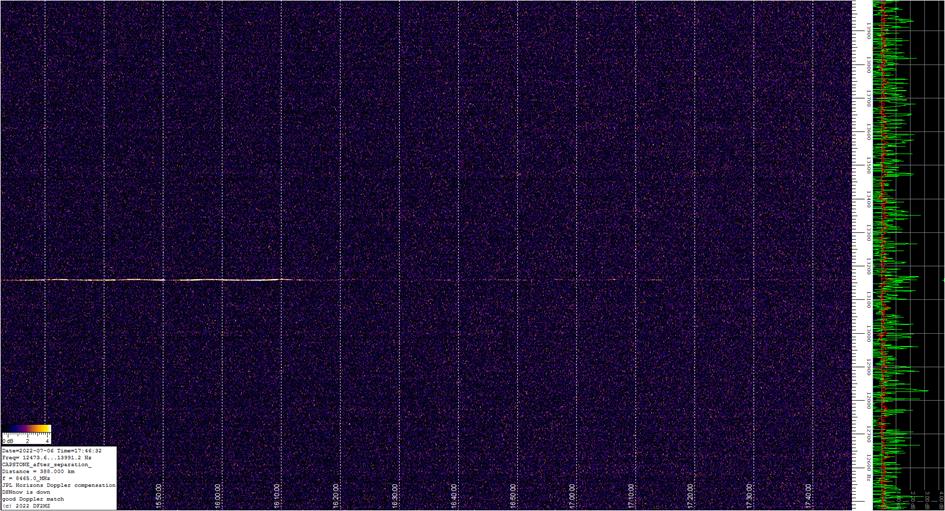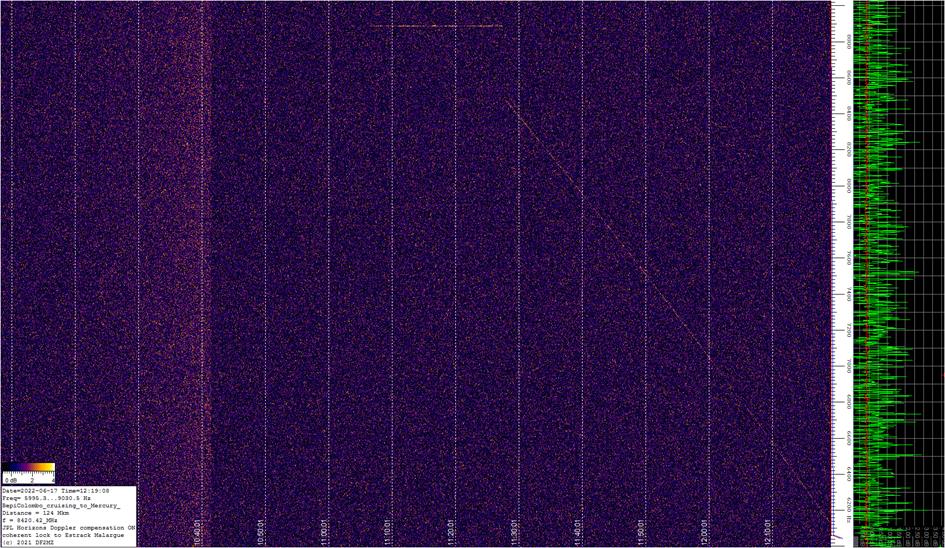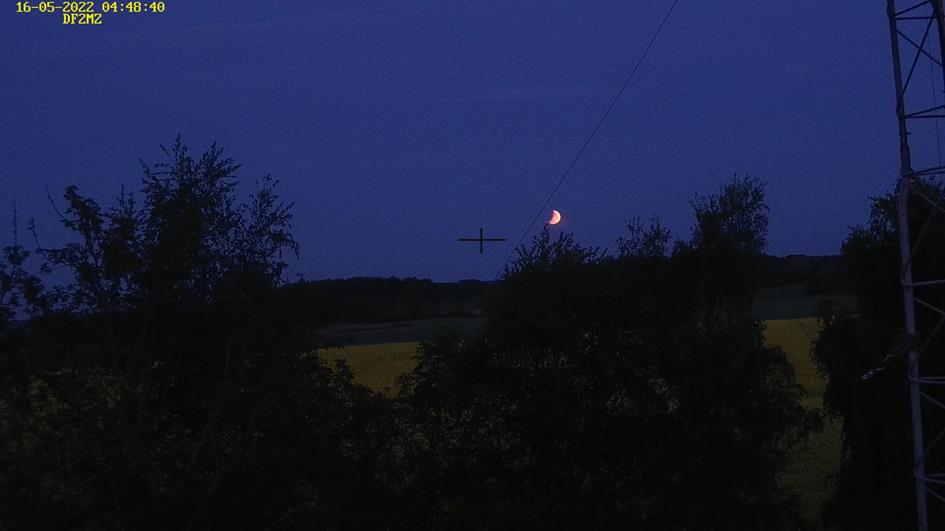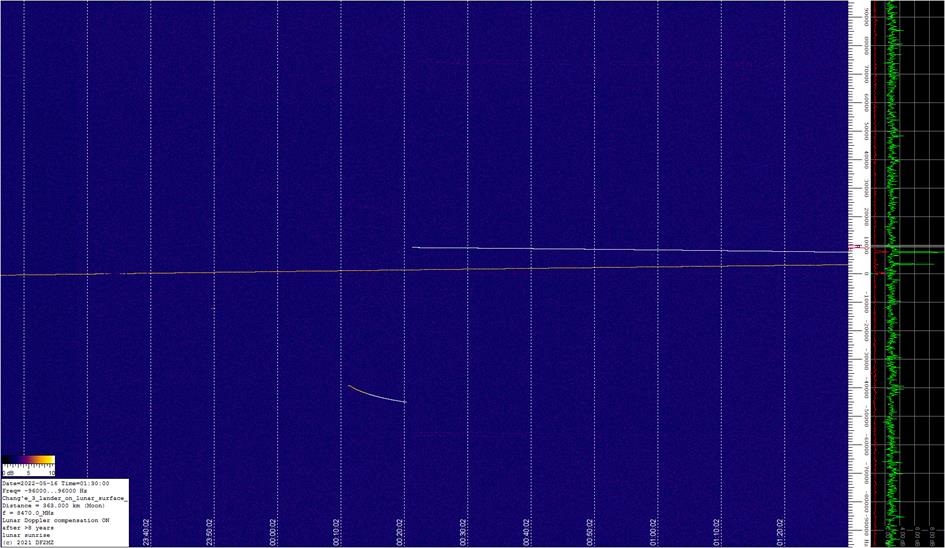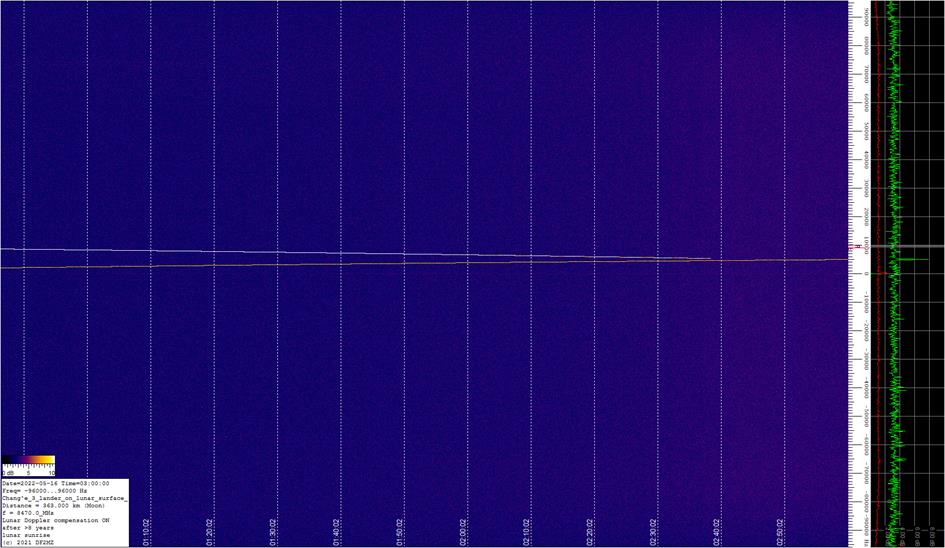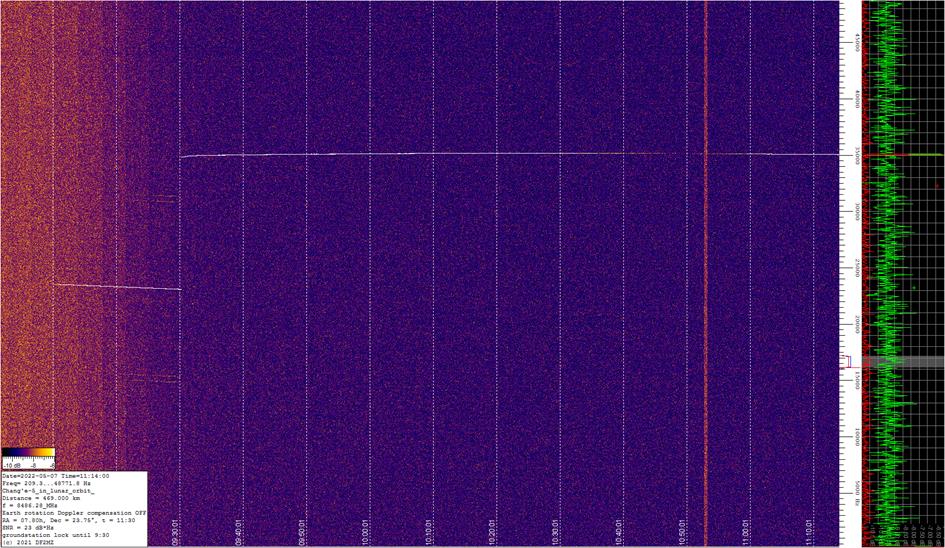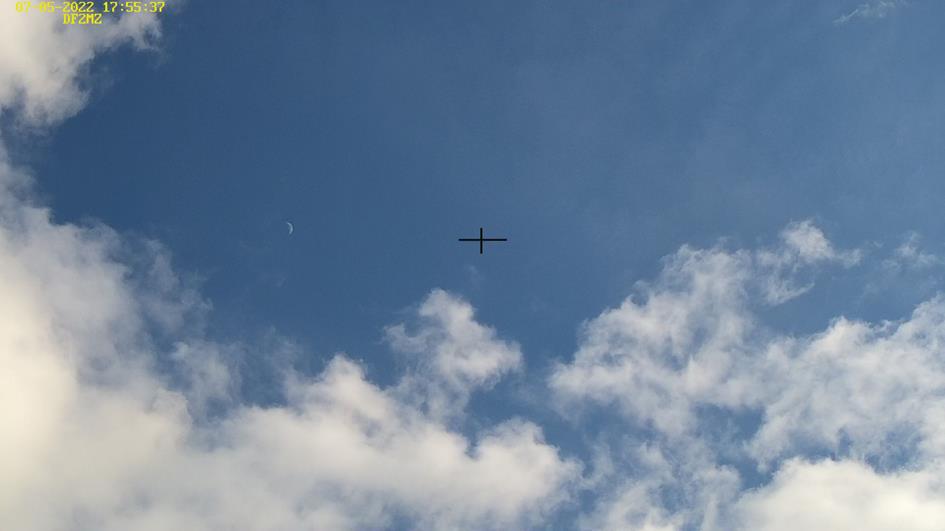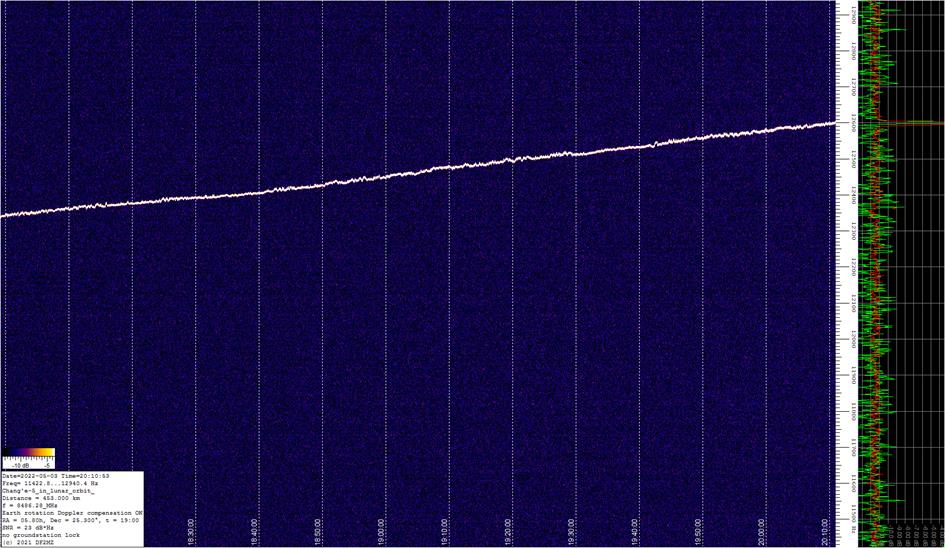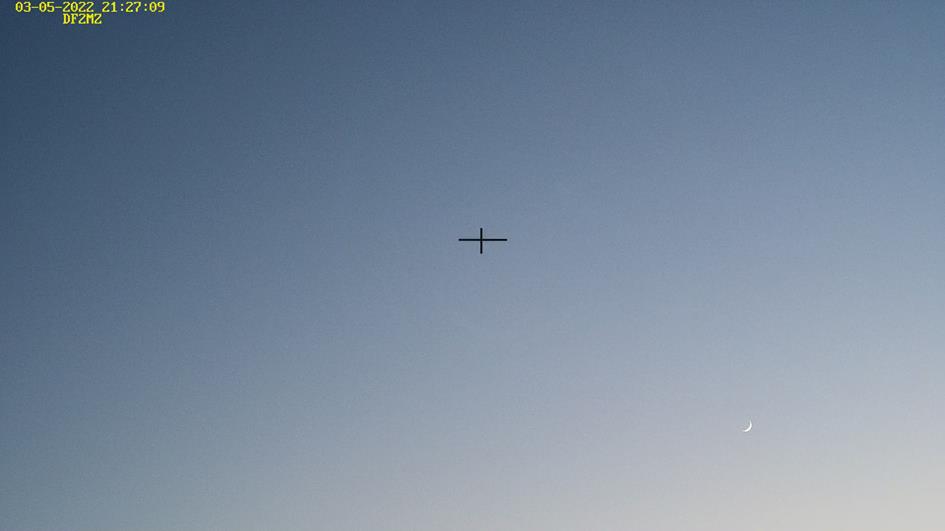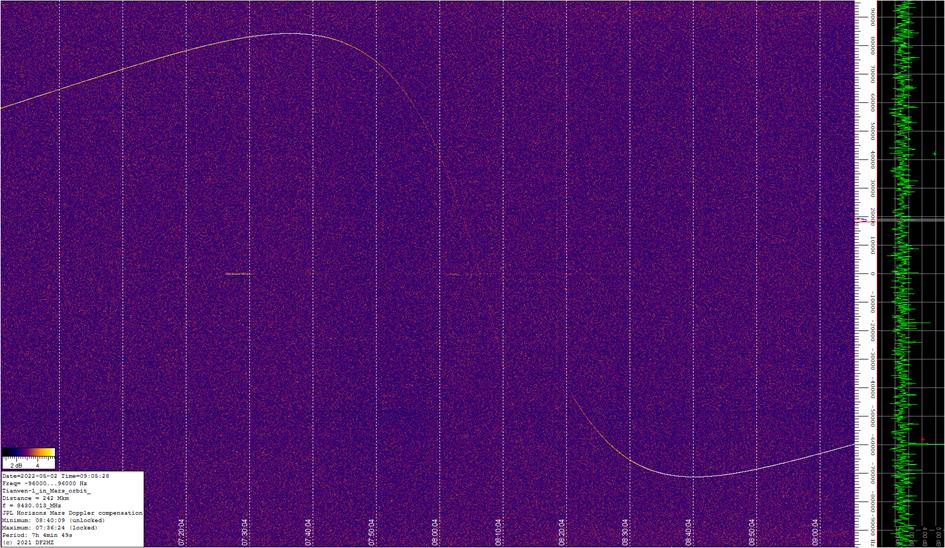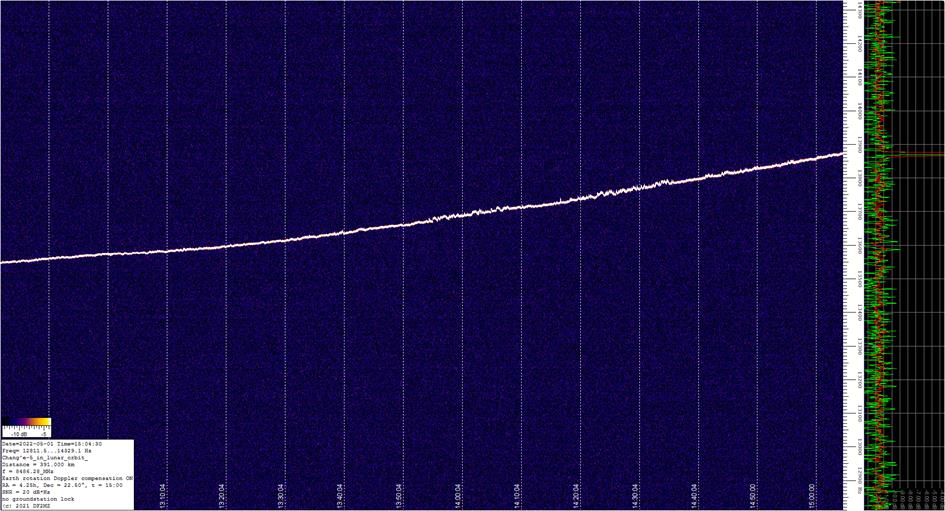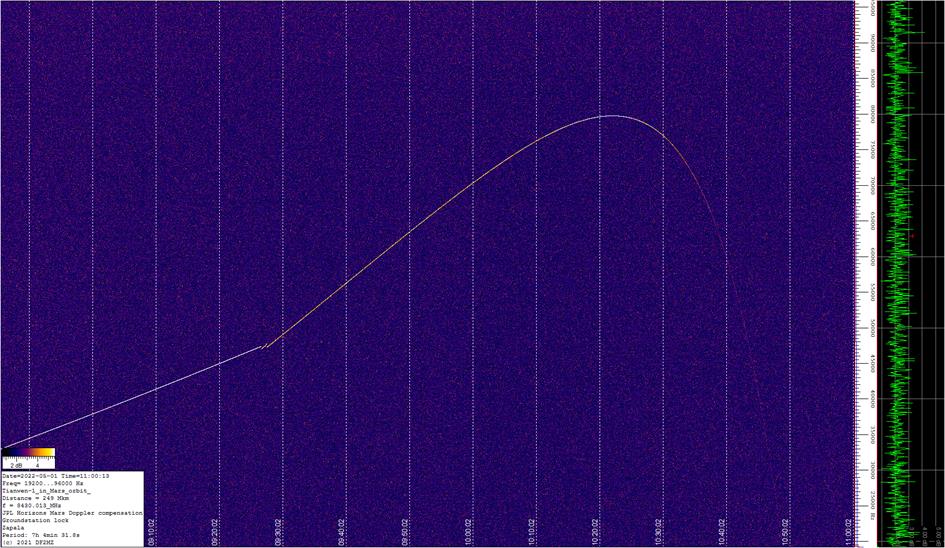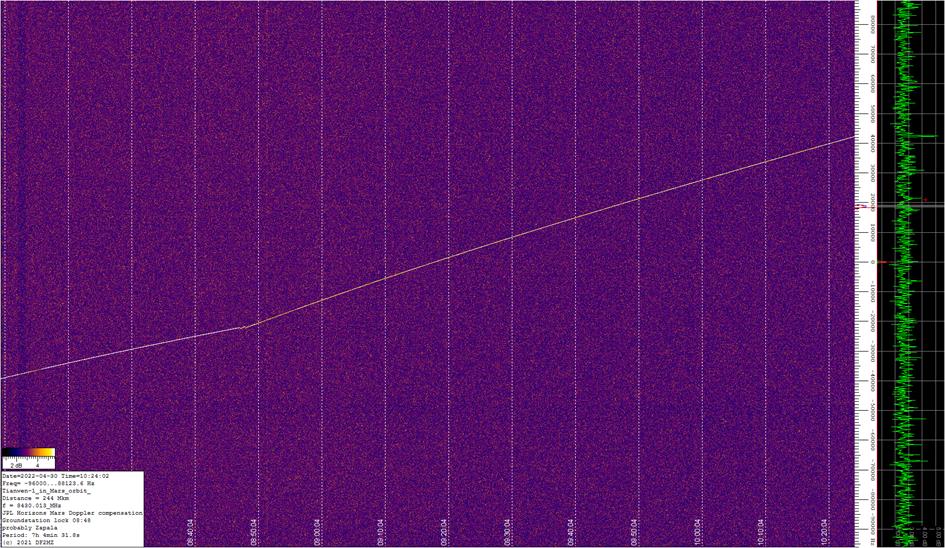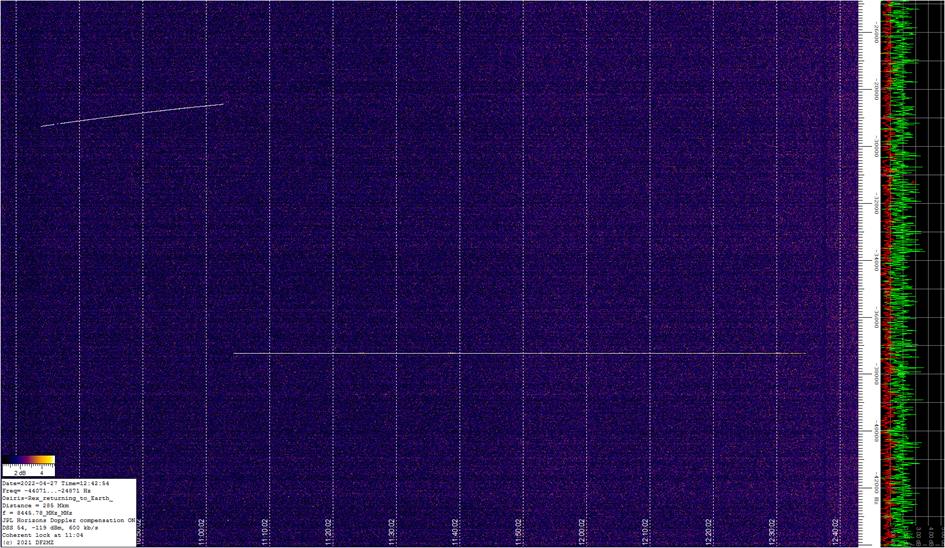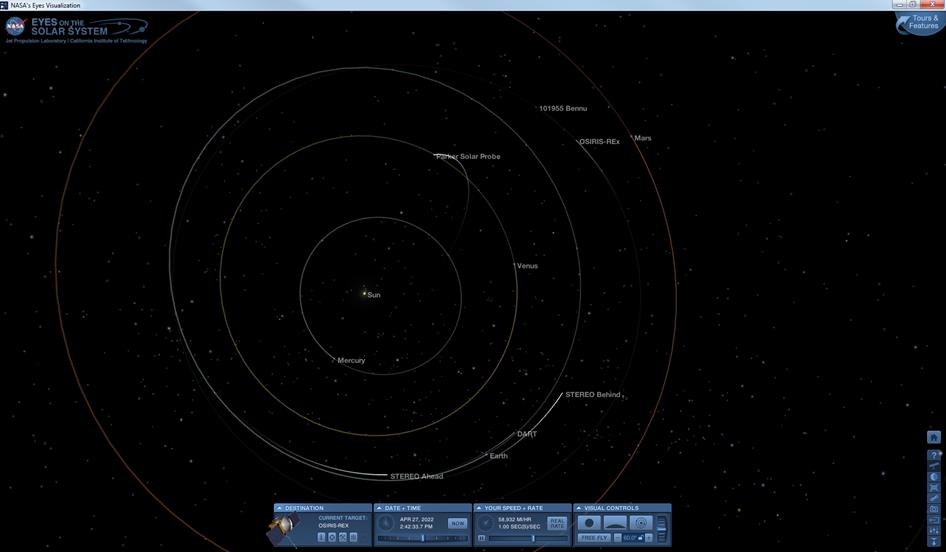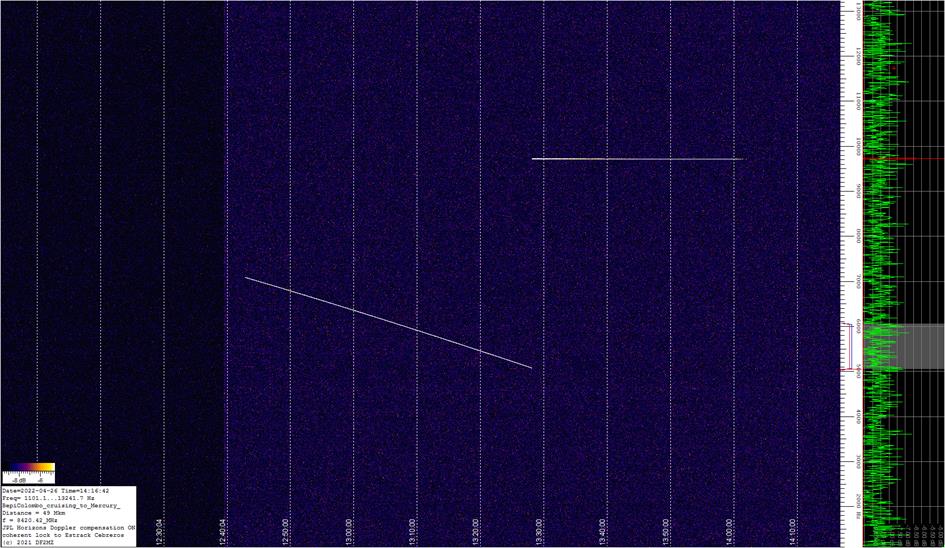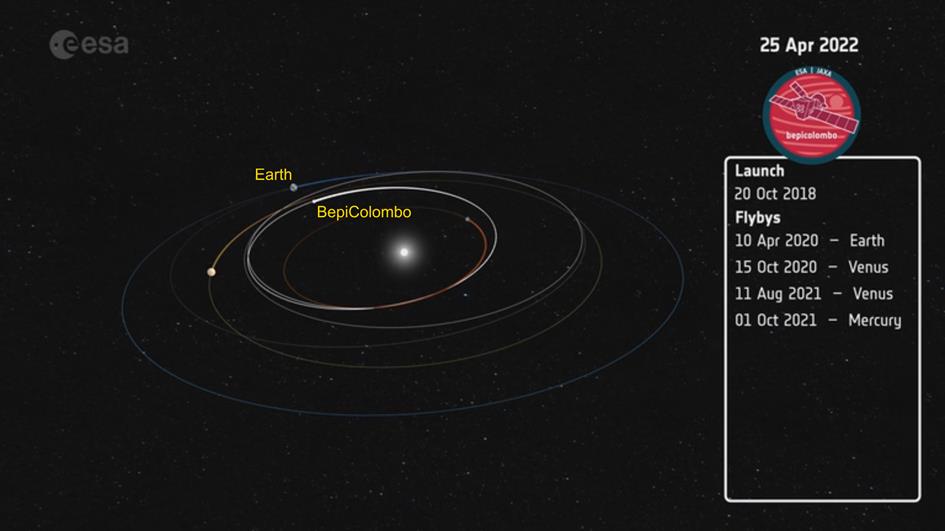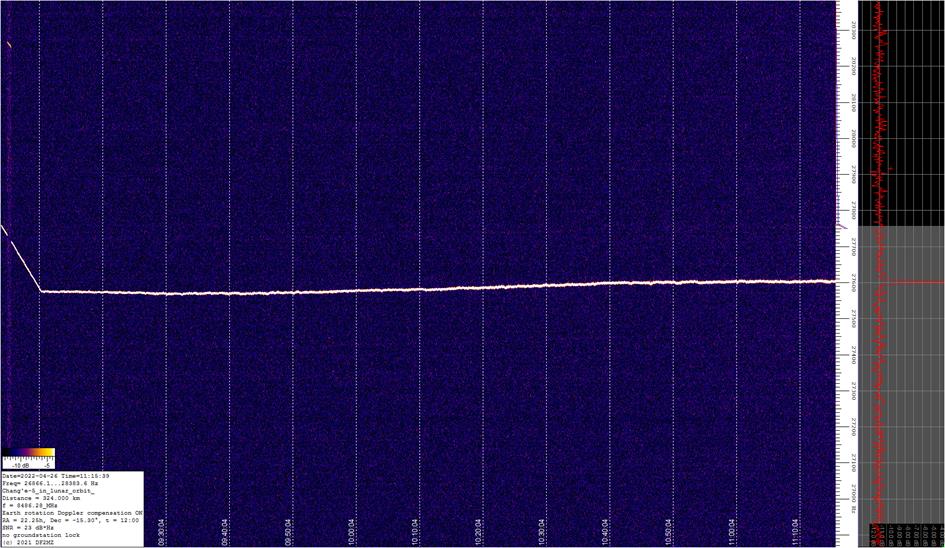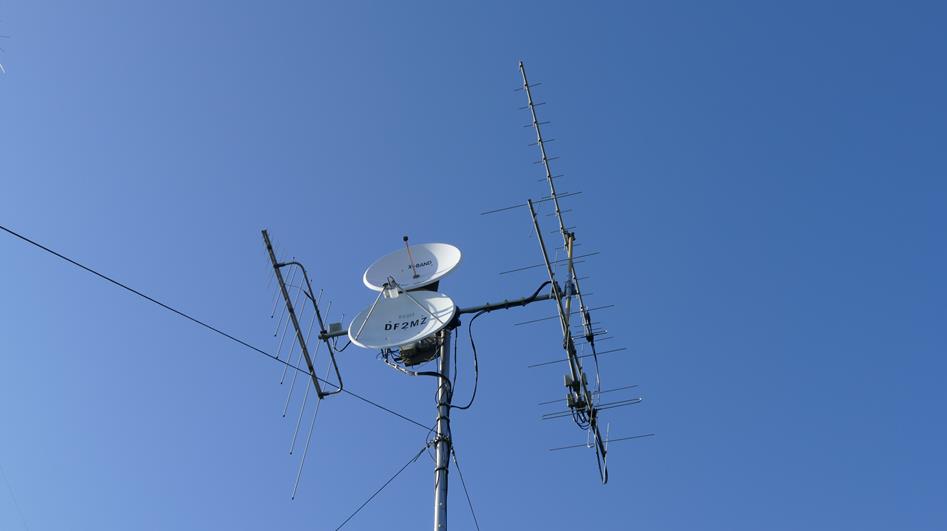DF2MZ – Edgar J. Kaiser – Kiel –
Germany
Welcome
to df2mz.de!
This is my new web presence. It will be a little
basic for some time, but I hope it will evolve into an attractive blog about my
activities in physics, deep space monitoring, the cats and more. Times are UTC.
Email: df2mz@df2mz.de.
Please give credit to http://df2mz.de in case
you use this material or refer to it. Thank you!
I am sending out an email alert whenever this
blog gets updated or I stream on Youtube. Drop me a
message if you want to be added to the list. List
members are not disclosed in the alert.
0072, 28.02.2024, 16:32, #Chang’e-3
The Chinese Chang’e-3
spacecraft landed on the moon on December 14th,
2013. It deployed a rover called Yutu which remained
fully operational until January 25th, 2014 and operational without drive
until August 3rd, 2016.
The lander module is active
until now and I received the signal this morning on x-band 8470 MHz. It is the
typical sequence comprising a roughly 10 min long free drifting transmitter,
which then locks to a ground station and remains active for about an hour. This
signal is emitted at least once a month in the days
after lunar sunrise. The coherent locking proves that the lander
is still actively supported by the Chinese controllers.
I will try to find out if the
signal comes up again during this lunar day and may be towards lunar sunset.
The second image shows the
lunar footprint at the time the signal appeared. This activity may have been supported by the Kashi ground station in the
western Xinjiang province.
My congratulations to the CNSA
team for this remarkable 10th anniversary on the lunar surface.

0071,
14.01.2024, 16:37, #SLIM
I have been following the
Japanese moon lander SLIM since its launch but didn’t
publish any result so far. SLIM is now in lunar orbit and the landing is expected for 19. Januar around 14 UTC. I may be able to observe
the radio signal during landing in real time.
This morning the initially
highly elliptical orbit was circularized. I couldn’t observe the burn itself because the moon was still
below horizon when it took place. However, I see the spacecraft’s signal now
and can compare the Doppler characteristics to earlier observations.
Below is the Doppler profile
of the new circular orbit, measured over two full orbits. We see a symmetric
curve, typical for a circular orbit with a mean altitude of 537 km.

Here is the trajectory as seen
from my station, showing the transition from the elliptical orbit to the
circular orbit. Trajectory data from JPL Horizons.

Here is the moon phase taken
at the time the Doppler profile on top of this entry was
taken. The spacecraft is now whizzing around the lunar limb as shown in
the trajectory plot. This orbit will rotate into the lunar disc in the days
ahead. The separation from the terminator will remain more or less constant.
Picture from https://svs.gsfc.nasa.gov/gallery/moonphase/

Here is the Doppler profile of
the initial orbit. It is asymmetric, typical for a highly elliptical orbit with
an orbital period of roughly 6h 20min.

Another orbital manoeuvre is announced for 17. January around 13 UTC. I may be able to
observe in real time.
0070, 07.01.2024, 07:10, #Peregrine
The Astrobotics Peregrine lunar lander is
scheduled to launch on Monday, 8. January at 07:18 UTC
and is planned to land on the moon on 23. February. A pre-launch planning
trajectory was made available on JPL Horizons. It took
me some search effort to find the x-band frequencies: 8492.315 MHz downlink and
7228.117 MHz uplink. The frequencies are not listed by
ITU, as usual, but could be found in some FCC documents that are available in
the internet. More information about the mission and a visualization of the
trajectory can be found on https://spaceflightnow.com/2023/11/01/astrobotics-peregrine-lander-arrives-in-florida-ahead-of-christmas-eve-moon-bound-launch/
At my location in northern Germany
the spacecraft will become visible around 15:00 UTC on Monday. I have a few
time constraints but if possible I will try to stream
my acquisition of signal on my youtube channel DF2MZ. There won’t
be an extra announcement, except to the mailing list for this website.
0069, 01.08.2023, 17:46, #Chandrayaan-3
Last night Chandrayaan-3
appeared at my southeastern horizon at around 21:00 after the translunar
insertion burn. The signal on 2241.6 MHz was loud and deviations from the
planning trajectory (from JPL Horizons) seemed to be small. Everything looked
good and I could assume a successful burn.
The other plot shows the
relative positions of Chandrayaan-3 (the ‘extra’ object) and the Moon. The
spacecraft will slowly approach the Moon over the next few days. According to
JPL Horizons data the periselene will occurr around
14:00 UTC on August 5th. If this is correct
I won’t be able to observe the event, because the Moon will be below horizon
here. Observers in the Americas may have a chance.

0068,
24. July 2023, 19:13, #Miscellaneous
This morning I decided to
leave Twitter and delete my account when indeed the Twitter
bird was replaced by an X. It is not just a new logo,
it stands for a completely new adjustment of Twitter in future. This is being
discussed intensively and I won’t contribute to that.
I decided that I don’t want to be part of this transformation,
even though I only posted announcements without content and removed my complete
timeline after Elon Musk bought twitter. Twitter is no longer the environment I
want to be present in, in which form ever.
For those who want to follow
my work in future I am assembling an email list to announce news in the blog
and other activities such as live youtube streams of deep space signals. Or you just set a bookmark and browse along in between. I am
currently not planning to join any other social platform. Instead
I will invest my time to cast the current clumpsy blog format into something
more structured. May still take a while though.
If you want to be included in
the list, please drop me an email to df2mz@df2mz.de
. The members of the list will of course not be disclosed
in the messages. Thank you for your interest and hope to hear from you.
0067,
21. July 2023, 17:38, #Chandrayaan-3
It turned out that it was
possible for me to observe the perigee burn yesterday on July 20th. The spectrogram below shows the
complete pass. Around 23:00 the signal begins to
emerge from the noise after it became visible from behind the forest. Around 04:45 a small frequency shift indicates coherent lock to a
groundstation. Around 07:45 the spacecraft unlocks
from the groundstation, again indicated by a small frequency shift.
So far
my station didn’t compensate Doppler and the trace shows the orbital Doppler
profile. At 08:10 I activated orbital Doppler
compensation which is indicated by a large frequency shift in the plot. The
spacecraft frequency didn’t shift in this moment. I
was using Space-Track TLE, and this way only nominal orbital Doppler is compensated but not Doppler contributions form the orbit
planning. This is different to the preceding post where I was using JPL
Horizons data to compensate. Horizons data already comprised the manoeuvre
while the TLE do not.
This time we see the absolute
efffect of the burn while in the preceding post only deviations from the orbit
planning are visible.
Some horizontal traces in the
plot are local interference while some very steep traces are interference from
LEO satellites.
The second plot shows the
manoeuvre in a detail display. I cannot rule out that a fraction of the
observed Doppler profile is due to inaccuracies in the TLE and not to the burn.
0066,
18. July 2023, 17:01, #Chandrayaan-3
This morning I was observing
Chandrayaan-3 on 2241.6 MHz before its perigee manoeuvre. The signal trace on
the spectrogram is compensated for my downlink Doppler
using NASA JPL Horizons ephemeride. Compensation was excellent and there
obviously was no coherent lock to a groundstation. ISRO announced the burn for
a time interval from 14:00 to 15:00 IST. This might correspond to Doppler
deviations starting at 8:30 UTC and lasting until 9:10 UTC when I lost the
signal because the spacecraft set for my location. I believe the planned burn
was already included in the Horizons ephemeris and range rate data.
What we see in the spectrogram
may be small deviations from the planning data. The engine may have been
controlled in a certain way in real time to achieve the best result for this apogee raising manoeuvre. This control action was likely not
included in the Horizons data and resulted in the oberved frequency
fluctuations.
It looks all very smooth and
ISRO reported a new orbit of 51400 km x 228 km orbit as
planned. The next manoeuvre is announced for July 20th
and unfortunately the spacecraft won’t be in view of my station then.
I want to mention that ISRO’s
public outreach has improved in this mission. They announce milestones and
allow publication of orbit data by JPL Horizons. Thanks for sharing this
exciting mission with the global public.
Addendum
25. July 2023: More observations of perigee passes suggest that
the frequency fluctuations in this plot are not a result of the burn, but
rather inconsistencies between JPL Horizons ephemeris data and the real
trajectory. Orbit prediction around perigee is notoriously difficult because
spacecraft velocity is very high.
0065,
15. July 2023, 06:53, #Chandrayaan-3
Chandrayaan-3 made me get up
at an unfriendly time, 03:00 CEST, this morning to catch the first option to see
a signal from the spacecraft. Strong signals were visible at 2217.12 MHz and
2284.56 MHz. Both frequencies were used by
Chandrayaan-2, the latter one for the lander. I learned about the new
frequencies 2203.00 MHz and 2241.60 from Roland @DF3LZ. Roland cites his
source, which I don’t have access to.
I am not showing spectrograms
because they are a little messy due to the many frequency changes. I hope to
record something cleaner in the days ahead.
I didn’t
see a signal on the known Chandrayaan-2 frequencies on x-band.
Meanwhile TLE for the
geotransfer orbit are available. That makes it convenient to plot the orbit in
a satellite-tracking program. The NORAD ID is 57320.
It won’t
be possible for me to observe orbital manoeuvres because they will be taking
place in perigee which is not visible for me. One planned apogee burn to raise
the perigee might be observable but I don’t know the
timing.

0064:
14. July 2023, 09:49, #Chandrayaan-2
The Indian Chandrayaan-3 moon
lander was successfully launched today. My
congratulations to the ISRO team. I was testing my s-band system and was using
the moon orbiter Chandrayaan-2 on 2217.12 MHz for this. The spectrogram shows a
full orbit with groundstation lock quickly after AOS. The signal is relatively
weak and only clearly visible around the Doppler extrema. So, the s-band system
works and is ready to acquire the Chandrayaan-3 signal once it becomes visible
here.
The Chandrayaan-3 trajectory
is on JPL Horizons, although it is a little bit hidden.
It is not on the spacecraft list, but can be found by
a search. The ID is -158. According to this it should become visible here above
the forest around 00:30 UTC. The most likely frequency is 2230.80 MHz.
0063:
25. May 2023, 09:32, #Exomars
Yesterday evening Exomars 16 –
TGO emitted a transmission intended to simulate an alien message from the
stars. Details of this activity can be found there: https://asignin.space/decode-the-message/
While it is debatable whether
something like this is in any way realistic it can create some attention to the
work of SETI.
It was indeed a nice
opportunity to receive a signal from the spacecraft in Mars orbit with my small
x-band antenna. Most times Exomars-TGO is transmitting in a mode without
residual carrier. This is efficient because all the transmission power can be used to transport content. However, it makes the
signal invisible for small amateur deep space stations like mine. I need a
residual carrier to detect the signal and make it visible.
The spectrogram below shows
the event. The signal showed up at 18:48 when the spacecraft appeared at the
eastern rim of Mars after a far side pass. Along the subsequent near side pass it exhibits some frequency pattern. I believe this is
due to some kind of uplink modulation. Estrack Cebreros was supporting the
activity. At 20:05the signal disappears because the spacecraft goes behind Mars
again and the signal path is blocked by the planet. At
20:45 the signal comes back when the spacecraft shows
up from behind Mars again.
A few minutes later the
spacecraft changes to a carrierless mode and the signal gets invisible for me.
Of course
I cannot decode the digital message that was transmitted. I can only see the
carrier. However, in case we saw a carrier signal with such a frequency profile
from the stars and we could rule out a terrestial origin or a transmission from
a space probe, it would be a proof of an intelligent origin on its own. Such a
narrowband signal cannot originate from a natural source we know about. It can only be generated by a technical transmitter. Of course it doesn’t contain any detail information. It only
tells ‘we are here and we are smart enough to generate and transmit a radio
wave’.
The signal is Doppler
compensated using JPL Horizons data. Without compensation
the signal trace would mainly show a Doppler profile resulting from its orbital
motion and earth rotation. It would probably be invisible too, because the fast
Doppler rate makes the FFT less sensitive. I would only see Doppler extrema and
nothing in between.
I saw the TGO signal only one
time before in this mode and that was some 2 years ago.
The other picture shows TGO’s
orbit around Mars as calculated from JPL Horizons ephemerides for the
spacecraft and for Mars.

0062:
23. April 2023, 09:38, #Hakuto-R
I continue receiving x-band
signals from Hakuto-R while it is still orbiting the moon in an approximately
100 km high orbit. The residual carrier is very weak and it won’t
be easy to observe the landing on Tuesday, 16:40 UTC due to the high orbital
Doppler rate. Once landed I am pretty confident that I
will see the signal, because the Doppler rate will be low on the surface.
Hakuto-R’s orbit will probably be similar to the picture below. It is an
estimate derived from my earlier observations. This website https://www.unistellar.com/de/blog/observe-hakuto-r-landing/
says Hakuto_R’s landing site will be Atlas crater, marked by the red circle in
the picture. It is quite a good match with my orbit estimate.
With my current knowledge of
Hakuto’s orbit I think the spacecraft will be approaching
from the north. However, there may still be orbital manoeuvres and I will try
to refine the estimate on Monday and/or Tuesday.

Moon image from: https://svs.gsfc.nasa.gov/Gallery/moonphase.html
0061:
21. April 2023, 08:40, #Hakuto-R
This morning Hakuto-R’s x-band
signal remains visible along the complete orbit. This means that the spacecraft
is whizzing around the lunar limb. The picture below shows the currently very
slim fresh crescent moon and an illustration of Hakuto’s orbit. It also means
that the spacecraft is in a polar orbit. Such visibilty is not possible in an
orbit with lower inclination. LRO and Chandrayaan-2 are in similar orbits with
different phasing and different altitude. The spacecraft is orbiting over the
terminator on the moon. This will probably stay like this and the landing will
take place somewhere just a little to the right of the terminator. The
terminator will have moved into the lunar disc by then. This way the lander can
take advantage of almost the complete 14 earth-days long lunar day. I hope to
see signals from the surface for almost 14 days. The lander and its payload are
probably not fit to survive the freezing lunar night. Of course, I would love
to be proven wrong and to see signals again in the
next lunar morning.
During the extrema of the
Doppler trace in the spectrogram, the spacecraft is close to the poles. I can’t say which extremum coincides with which pole. The
x-band signal became visible for me at 06:00, it
locked to a groundstation at 06:30. It unlocked at 09:12 and disappeared a few
minutes later. It may come back later today.
Good luck for the landing on
Tuesday, April 25, 16:40 UTC.

Moon image from: https://svs.gsfc.nasa.gov/Gallery/moonphase.html
0060:
18. April 2023, 08:34, #Hakuto-R
This morning I detected two
subsequent Doppler minima in Hakuto-R’s x-band signal. This allows to determine an orbital period of 7066 seconds, that is 1
hour, 57 minutes, 46 seconds. The corresponding mean altitude is 99.9 km. In
both minima the signal was locked to a groundstation.
The spacecraft is scheduled for landing on April 25, 16:40 UTC. The map
below shows the visibility of the moon at that time. It will be perfectly
visible over Europe and for my station, but not over Japan. It
will probably be handled by Estrack Cebreros in Spain. The signal has
recently been pretty weak, but there may be a chance
to see the signal during the landing sequence.

0059: 15. April 2023, 07:22, #JUICE
I like long
term observations. I recorded a spectrogram of JUICE’s first pass after
launch over my location in northern Germany. We see two groundstation
handovers. The first one may be a handover from New Norcia to Cebreros. The
second one then to Malargue. But I didn’t verify that.
The frequency profiles are due to uplink Doppler from the groundstations, which
was not compensated for. My downlink Doppler is compensated. Without uplink from a groundstation
we would see a horizontal signal trace. The short gaps at the beginning (left
side) are due to local tests.
Please ignore the legend of
the picture, it was not updated for this very new
spacecraft yet.
0058:
14. April 2023, 17:39, #JUICE
After the successful launch I detected JUICE’s x-band signal on 8436.05 MHz (at
spacecraft) after it rose here over the southeastern horizon. It is a very
strong signal with over 40 dBHz SNR in my small 1 m dish antenna. The
spectrogram shows rising Doppler due to the groundstation uplink. I am
compensating my downlink Doppler.
Congratulations to the ESA
team and everyone involved into this exciting project. Thanks to the fabulous
JPL Horizons team for providing the pre-launch trajectory to the public.
0057:
10. April 2023, 06:37, #Tianwen-1
I did some long term
monitoring of Tianwen-1 in the last days. The two spectrograms show complete
Mars passes, which are long theses days, more than 17 hours. We note LOS events
on the rising part of the Doppler curves. I am now pretty
sure that those are not a result of some groundstation interaction. They
are due to occultations by Mars. The spacecraft is going behind the planet and
the radio signal is cut. The occultation lasts some 70
minutes. The signal is not always coming back after the occultation. This
depends on the spacecraft’s agenda. Those LOS events are in phase with the
orbital period of 7h 4min 44s. The occultations will change over time and sooner or later we will see the full orbit again. This was
the case for a long time. I was expecting to see occultations sooner or later and now they are there.
It would be interesting to
have this confirmed by people with a more quantitative understanding of the
Tianwen-1 orbit.
0056:06. April 2023, 06:41, #Hakuto-R
Last night Hakuto-R showed
quite some activity and I observed two subsequent Doppler minima. The first one
around 20:25 and the following one around 00:25. Still not very precise timings
because the station was running in unattended mode. However, I can state with
some reasonable certainty that the spacecraft is now in a 4 hours orbit
plus/minus a few minutes. This corresponds to a semi major axis of
approximately 2953 km. I cannot say since when it is in this orbit.
The second spectrogram shows
some groundstation interaction too.
0055:
05. April 2023, 05:49, #Hakuto-R
I observed Hakuto-R last night
and saw a few activity intervals. The first started at 21:42 and the last ended
at 23:35. Look at the slowly falling signal traces in the spectrograms. They are interrupted a few times. The horizontal traces are local
interference. The signal is very weak. When the probe was heading outward it was at least ten times stronger at a comparable
distance. Even at SEL2 distance it was stronger than
it is now. My observations are not sufficient to determine a precise orbital
period. I think it is still in an approximately 8 hours orbit and not much has
changed since lunar orbit insertion. The owners ispace
aren’t sharing any information about orbital parameters. I hope they will be
sharing the timing of the landing, which is announced for later this month.
0054:
03. April 2023, 08:21, #Chang’e-3
Last night the Chang’e-3 lander on the lunar
surface in Mare Imbrium was active on x-band again. It followed the usual
pattern. It switched on, drifted for 10 minutes and then locked to a
groundstation. The slowly falling Doppler profile results from groundstation
uplink Doppler.
The moon was not visible over China when
Chang’e-3 started up. This activity must have been supported
by the groundstation in Zapala, Argentina.
Quite amazing to see that the lander is not only
emitting radio signals after more than 9 years on the moon’s surface, but is
even actively being supported from Earth.

0053:
25. March 2023, #Hakuto-R
I observed Hakuto-R all day and it showed two
downlink sessions. First with Estrack Cebreros and then with Estrack Malargue. Four
days after lunar orbital insertion it is quite difficult to evaluate orbital
landmarks in the Doppler profiles. I think the spacecraft is in an essentially
polar orbit and these days we are looking from a perpendicular direction on the
orbital plane. This means that the orbital Doppler profile is shallow and the
resulting uplink Doppler profile superimposes. What I read from the curves is
that the orbital period is 8 hours or a little less. I think that no orbital
manoeuvre or only small manoeuvres were carried out
after the lunar orbital insertion four days ago.
In the days ahead, we will increasingly be
looking at the edge of the orbital plane and it will become easier to extract
orbital parameters from the observations. We will probably observe occultations
by the moon as well.
0052:
24. March 2023, 17:57, #Hakuto-R
I let the station on after the periselene pass
until moonset around 16:50, which is indicated by LOS
on the plot. The spacecraft showed a grounstation handover at 15:00.
Unfortunately, I couldn’t evaluate the second
Doppler maximum because it occurred after LOS, but based on the Doppler profile
I can estimate an orbital period between 8 hours and 8 h 30 min. This
corresponds to a semi major axis between 4687 km and 4880 km. I have no idea
whether this is a polar or an equatorial orbit or something in between.
This result is now more than 3 days old, so
things may have changed by one or the other manoeuvre.
The Japanese owners
ispace are not sharing any significant data. Those are the joys of private
spacefare. There is no commitment to public outreach except some marketing
propaganda facilitating their commercial interests. Nevertheless, I am pretty sure that most of the budget of such a project comes
from the taxpayer in unknown indirect ways. I don’t
like the concept, to be honest.
I will carry on observing the thing in order to
provide at least a minimum of information to the public.
0051:
21. March 2023, 10:45, #Hakuto-R
Now we have the beautiful Doppler curve of a
periselene pass of Hakuto-R. This makes me quite confident that the spacecraft
is now in a highly elliptical orbit around the moon. If the prognosis of the
first periselene pass at 01:34 UTC this morning by Bill Gray’s ephemerides is correct,
it the orbital period may be around 8 hours. This can be determined more
precisely after a next Doppler maximum or minimum. Also
the semi major axis can be determined then. I won’t be
able to observe that today because the moon will set before. Click on the image
to see the extrema timing in the legend.
Ispace are still
remaining silent.
0050:
21. March 2023, 09:00, #Hakuto-R
Hakuto-R locked to an unknown groundstation at
07:57. None of the Estrack stations showed respective activity. At 08:53:16 I observed a Doppler maximum. This can be an
indication of a lunar orbit but is not yet a proof. I will be more convinced
when I see a Doppler minimum.
I am now pointing at the moon and I am
compensating for my earth rotation Doppler. Bill Gray’s Hakuto ephemerides are
no longer available after the prognosed periselene last night. Thanks Bill for
giving directions until then.
Ispace are remaining silent so far.
0049:
19. March 2023, 16:57, #Hakuto-R
I think I saw two short activities of Hakuto-R
today. It switched on, drifted for a few minutes and switched off. There was no
indication of a groundstation lock. First occurrence was around 08:40, second
was around 11:35. I cannot rule out that it was local interference but the
frequency profile is similar to earlier observations.
None of the Estrack groundstations showed an
assignment to Hakuto-R today.The spacecraft was not visible over Japan when
those emissions occurred.
0048:
18. March 2023, 11:43, #Hakuto-R
Hakuto-R switched on this morning at 08:55,
remained unlocked for a few minutes and locked to Estrack Malargue
groundstation indicated by a frequency shift of almost 60 kHz. It remained
locked until it set at my location. The Moon is climbing up in elevation these
days and my observation window will get longer.
The spacecraft is now about 3° separated from the
moon and is about 60.000 km behind the moon. The lunar orbit insertion
manoeuvre is announced until end of March but not much
(nothing?) is known about intended orbital parameters.
0047:
15. March 2023, 08:24, #Akatsuki
By chance I noticed that
the Madrid NASA deep space complex had assigned not less than four antennas to
the Japanese Venus orbiter Akatsuki on March 9th. Akatsuki is at a
distance of almost 200 million km these days and it is a weak signal for my
small 1 m antenna. I decided to monitor the frequency in a slow running plot
with 1 minute integration intervals. Akatsuki has a
very stable signal frequency and ephemeride data from JPL Horizons is very
accurate. This way such long signal integration is feasible with precise
Doppler compensation in my receiver.
The patience was rewarded and I saw an almost two
hours long downlink signal as shown in the spectrogram below. At the time of
the observation the Venus orbiter was in the apoapsis
orbital phase. Akatsuki’s orbit is visualized here: https://akatsuki.isas.jaxa.jp/en/gallery/orbit/
Currently the fabulous DSN Now website is not
operational. The DSN schedule can nevertheless be found
here for Madrid: https://www.mdscc.nasa.gov/index.php/en/mdscc-antennas-weekly-schedule/
and here for Canberra: https://www.cdscc.nasa.gov/Pages/trackingtoday.html
To my knowledge, DSN Goldstone are not publishing
their schedules.
0046:
27. January 2023, 08:58, #Hakuto-R
The ongoing observations of Hakuto-R showed the
signal with some frequency drift, which is not related
to uplink Doppler. I decided to record a long-term spectrogram to get a better
view on the situation. The long-term plot reveals a periodic frequency
modulation with a period of some 2 h 30 min. This is most likely the result of
a spinning spacecraft. Spacecraft often spin for thermal equilibration and axis
stabilization. This gives rise to periodic temperature changes that affect the
master clock oscillator of the communication system. A frequency amplitude of
100 – 150 Hz can easily be explained this way. The
frequency profile is not exactly repeating with the period. This may be due to
other thermally relevant activities like activity of the onboard computers,
battery charging and others. The signal is not exactly strong these days but
will be some 10 dB stronger when the spacecraft arrives at the moon. It will
then be an easy target for 1 m class antennas like mine.
0045:
25. January 2023, 16:35, #Hakuto-R
I saw this morning that Estrack New Norcia was
tracking Hakuto-R. When the spacecraft rose at my location, the Estrack session
was already finished but I decided to have a look nevertheless. Unfortunately,
the Hakuto-R trajectory is not public, JPL Horizons is not listing it and the
Japanese owners are not publishing it to my knowledge. We know that the
spacecraft was launched together with Lunar Flashlight, which is listed on JPL
Horizons and is also manoeuvering to the moon on a low
energy trajectory.
So,
my attempt was to point at LFL and do a spiral search around this direction.
However, Hakuto-R’s signal was there when pointing to LFL. Just a minor
optimization by pointing 1° above LFL in elevation optimized the signal. It is
weak but it is there. I asked other deep space observers to confirm but don’t have a response so far, neither negative nor positive.
So, at the moment I cannot rule out a local artifact.
I will keep on observing the spacecraft and I am
looking forward to its arrival at the moon and the landing. If you are a deep
space observer with x-band capability I would be happy about a notice whether
you can confirm or not. If you are from ispace, please consider to publish more
detail information about your exceptional project, particularly the trajectory.
I am sure JPL Horizons would be more than happy to process your data and
publish the ephemeris we amateurs rely on so much.
0044:
21. January 2023, 21:35, #Cat
Our sweet tigers are having a rest.

0043:
17. Jamuary 2023, 09:55, #Tianwen-1
I observed unlocked Tianwen-1 Doppler maxima on
10. January and on 16. January with 21 orbits in between (see image legends). This
results in an orbital period of 7h 4min 44.4s. Not a significant change to the
earlier value of 7h 4min 31.8s that I determined end of May last year.
0042:
6. January 2023, 08:07, #Chang’e-3
She is alive and fidgeting. The Chang’e-3 moon
lander emitted an x-band signal on 8470 MHz for more than an hour last night.
It locked to a groundstation after a short drift phase. This device has now
been active under the very harsh conditions on the lunar surface for more than
nine years since she landed in December 2013. And
obviously she is still being operated actively. I hope to see the 10 years
anniversary in December this year. Congratulations to the Chinese scientists
and engineers who made this remarkably sustainable system.
0041:
12. December 2022, 19:36, #Hakuto-R
The Japanese moon lander Hakuto-R shows a strong
x-band signal on 8492.54 MHz after it launched yesterday morning. The plot
shows the signal while the spacecraft is in coherent lock with Estrack’s
Cebreros groundstation in Spain. I am using the trajectory data from JPL Horizons
for Lunar Flashlight, which is on a similar orbit. Specific orbital data for
Hakuto-R are not available so far.
My station can also detect Lunar Flashlight but
the signal is much weaker.
0040:
3. December 2022, 09:05, #Capstone
I hadn’t heard much
about Capstone in its Near Rectilinear Halo Orbit (NRHO). It is not showing up
on DSNnow very often and the website of Advanced Space isn’t
very informative. So I decided to have a look myself.
The thing is active on x-band. I saw two activity phases last night. Each time
the same pattern. Roughly 5 minutes showing frequency drift, followed by 42
minutes with a frequency stable signal. Neither DSNnow nor NENnow showed either
of those activities, so a different groundstation must have handled it.
Horizons has recently published ephemerides
again. I was using those for the detection above.
0039:
1. December 2022, 11:23, #Mars Odyssey
Mars Odyssey was not detectable for me until a
few days ago. Whenever I tried, even with good signals indicated at DSNnow, I
never succeeded to see the signal. Until a few days ago. Mars is close to
opposition and thus only 81 million km away. This results in a strong signal
from all Mars orbiting spacecraft and helped to
finally detect Mars Odyssey as well.
It also shows why in general it is tricky to see
the signal. The x-band transmitter is not very stable. The downlink signal
exhibits strong frequency drift. When in coherent lock with a groundstation,
the frequency gets disciplined by the uplink signal.
The uplink, however, exhibits a frequency ramp for uplink Doppler compensation
that again smeares the signal and limits the efficacy of long
term signal averaging. The periodicity of the unlocked signal seems to
follow the orbital period of roughly 2 hours. It is unclear wht the reason for
this periodic drift is. It may be of thermal nature.
Well I am happy I could close this white spot on
my list of spacecraft in the Mars domain. Mars opposition will provide more
opportunity to observe Mars Odyssey before it disappears into larger distance
that makes it invisible for my small antenna setup.
The spectrogram below shows the almost complete
pass of Mars last night.
0038:
14. November 2022, 08:56, #CAPSTONE
CAPSTONE performed its Lunar Orbit Insertion Burn
into the Near Rectilinear Halo Orbit. I observed the signal along its
visibility last night. The downlink was interrupted in
between and was not active during the burn itself.
The spectrogram below shows the signal before and
after the LOI. I cannot determine the magnitude of the burn with this data. It
looks like something has happened and Advanced Space report a successful manoeuvre.
0037:
08. November 2022, 10:43, #Chang’e 3
The Chang’e 3 moon lander was active on x-band
again last night. The spacecraft has been sitting on the lunar surface in Mare
Imbrium for almost 9 years, and is still emitting x-band signals each lunar
day. Typically her emissions on 8470 MHz lasted about
an hour. It mostly follows the pattern as shown in the spectrogram below. The
signal shows up, drifts for some 10 minutes, locks to a groundstation, remains
on for about another 50 minutes and then switches off.
This time it was different .
The signal remained active and locked much longer. After unlocking from the groundstation it remained on for more than another two
hours. Signal strength went weaker and appeared to be intermittent for a long time , see the second plot for that.
Of course I cannot tell
if this observation is an indication for upcoming technical issues in the
x-band transmitter. I will keep on listening towards the moon along the rest of
this lunar day. The lunar eclipse on 8. November had
not yet started during my observation and it is not visible here in Europe.
American observers are in the first row seats.
For reference check blog
entry 0018 showing the last observation on 16. May 2022.
0036:
25. October 2022, 19:31, #Sun
Northern German weather doesn’t
care about interesting astronomical events. So,
today’s partial solar eclipse was not visible in the Kiel area due to cloudy
sky and rain. Ok, it wasn’t visible optically but I
was able to detect it on microwaves. I directed the x-band antenna towards the
sun and recorded noise power on 8427 MHz. The plot shows an intensity dip of
some -0.5 dB at the time of maximum exclipse at 10:15 UTC. The large
fluctuations before the eclipse are due to bad antenna alignment. The
fluctuations along the plot are most likely due to thermal noise from clouds
and rain showers in between. Given the eclipse magnitude of some
20% we would expect a dip of 0.97 dB. The discrepancy shows that my antenna,
just a 1 m dish is far from perfect.

0035:
17. October 2022, 12:32, #LUCY
I tracked LUCY’s x-band signal along today’s
complete pass. She emerged from behind the forest in the northeast in the
morning and set behind the trees in the northwest. At the beginning
we note the handover from a groundstation in Australia to the Madrid
groundstation. At the very end of the spectrogram she
unlocks from Madrid before setting.
Zooming into the frequency axis reveals the
interesting signal pattern resulting from uplink compensation. My station is
compensating for downlink Doppler in a continuous way. That means the receiver
is adjusted in one second intervals to keep the signal
at constant baseband frequency. With a spacecraft emitting a constant frequency this should result in a flat horizontal trace.
In some spacecraft such as LUCY
the groundstation compensates uplink Doppler. They aren’t
doing it continuously but rather apply stepwise ramping. This results in those nice ornamental signal wobbles. Each ramp
creates a new wobble. When the spacecraft culminates at the groundstation
location, the Doppler curve inverts its curvature, i.e. the second derivative
changes sign. This results in the wave pattern in the middle.
In the last part of the plot
I changed from compensating downlink Doppler to compensating for my Earth
rotation Doppler only. The rising profile indicates that the escape motion of
LUCY is slowing down because she is still feeling Earth gravity. She is still
within the Hill sphere.
In the last few minutes
I switched back to ephemeris controlled compensation. The spacecraft unlocked
from Madrid and set a few minutes later.
It is a very strong signal as LUCY is just some
0.5 million km away after yesterday’s Earth flyby.
0034:
16. October 2022, 10:47, #LUCY
LUCY’s x-band signal as far as I could see it
during the low pass this morning. The observation started at a distance of some
80.000 km and ended at 28.000 km when LUCY set here in the south. Signal
strength was continuously increasing.
She will come back after the flyby around 21:30
in a northeastern direction at a distance of already 230.000 km and escaping at
5.3 km/s.
Keeping fingers crossed for a flawless manoeuvre.
0033:
15. October 2022, 16:09, #LUCY
I was observing almost the complete pass of LUCY
today while she is approaching for an Earth flyby that will accelerate her on
her way to the Jupiter trojans. The spectrogram shows the typical signature
resulting from uplink Doppler compensation. The signal faded out because I was
accidentally using an outdated ephemeris file. In reality
the signal should have increased because the distance was decreasing some
585.000 km to 427.000 km.
I won’t be able to
observe closest approach tomorrow morning because the spacecraft will be below
my horizon. I will see her in a shallow pass in the southwest afterwards and
then coming back in the northeast in the afternoon.
At closest approach she
will even be inside the ISS orbit. Somebody clean up there from space junk, mega
constellations and the like.
0032:
9. October 2022, 09:56, #CAPSTONE
Since yesterday I observe an x-band signal on
Capstone’s frequency coming from its direction. The signal shows up each 118
minutes and the trace is about 6 minutes long with rising frequency profile.
The periodicity may be
explained by slow spacecraft rotation for thermal equilibration. This
may also explain the rising frequency, which can be due to thermal effects in
the spacecraft caused by the spin. If the spacecraft frequency was stable I should receive a flat line because my station is
compensating for downlink Doppler.
I think the observed pattern is not due to the
antenna pattern rotating into and out of my direction. AOS and LOS are too fast
for this. I think the signal switches on and off whenever the antenna points to
Earth. This can save a lot of power, which may still be somewhat critical on
CAPSTONE.
It was recently reported
that the uncrontolled tumbling of the spacecraft after an orbital manoeuvre
could be stabilized:
https://advancedspace.com/capstone-mission-recovery-success-update/
0031:
4. October 2022, 17:30, #Sun
Today I pointed the x-band antenna to the sun and
did a long term recording of the noise level. I intended
to find out if the sun’s x-ray activity as shown by GOES (https://www.swpc.noaa.gov/products/goes-x-ray-flux)
correlates with its x-band noise level. Well it certainly does, but the big
question is whether my station can detect that. And
indeed the M1.6 flare around 13:20 correlates nicely with increased x-band
noise at the same time.
It is interesting that the x-band signal exhibts
a sharp peak, while it otherwise follows the profile of the GOES x-ray signal. So, this was a moderate M-class flare. X-class flares may
show much higher noise outbursts.
X-band microwave signals and x-ray signals are
extremely different animals. The x-band wavelength is about 3.5 cm while x-rays
measured by GOES are in the nm-range. So there is a
ratio in energies of some 1:30.000.000.000. The physical processes of microwave
and x-ray generation are completely different.

Today’s GOES plot from
https://www.swpc.noaa.gov/products/goes-x-ray-flux

0030:
02. October 2022, 17:12, #MOM
According to news in Indian media
the Indian Mars orbiter MOM (Mars Orbiter Mission or Mangalyaan) is no longer
operational. The news say that the batteries were drained
during a long eclipse in April this year. This means that planet Mars threw its
shadow on the spacecraft and the batteries got completely drained. It was likely not
possible to recharge the batteries and realign the spacecraft after the
eclipse. It is not uncommon that batteries fail ofter
long lasting deep discharge.
https://economictimes.indiatimes.com/news/science/with-drained-battery-no-fuel-indias-mars-orbiter-craft-quietly-bids-adieu/articleshow/94599355.cms?from=mdr
MOM was launched on 5.
November 2013 and entered Martian orbit on 24. September 2014.
I was observing the mission from launch to its
end this year. The last time I observed and recorded the s-band signal on
2292.96 MHz was on 29. March 2022. It is probably one of the last emissions by
the spacecraft before the orbital eclipse and battery failure. The spectrogram
is shown below:
For a long period of time
the spacecraft was emitting daily 10 minutes long beacon signals. This was
taking place almost each day in the Indian afternoon. An example of the beacon
beeps is shown below:
I observed ground station interactions with MOM
in rare occasions. Here is the last observation of this kind on 8. March 2022:
MOM was designed for an
initial lifetime of 6 months in Martian orbit. The total lifetime of more than
8 years is a really remarkable result and success. I
will be missing this deep space s-band beacon. To my knowledge there is
currently no other s-band source in interplanetary space.
All my observation were perfomed with my amateur
deep space station using a 1 m parabolic dish.
ISRO is still to officially confirm the
decommissioning and details.
0029:
05. August 2022, 10:11, #KPLO
KPLO was successfully launched
last night and is now on the way on a long trajectory to the moon. The
spacecraft is currently heading in direction of SEL1 and is
expected to arrive in lunbar orbit in December.
I detected its s-band signal on 2260.8 MHz at a
distance of roughly 110.000 km. It is a strong signal in my RHCP antenna,
although there are rumours its signal might be LHCP. The plot shows the
spectrogram with Doppler compensation based on published Horizons ephemerides
at the left part. At 09:00 I switched to earth
rotation compensation for my station to show the geocentric Doppler. There we
see rising Doppler as is expected for a spacecaft
climbing up in earth’s gravitational field and thus slowing down its upward
movement.
It is not clear why the Horizon’s compensation
shows a falling frequency. It is expected to be a
horizontal line. NASA DSN 54 in Madrid is not showing a coherent lock so far,
only downlink is indicated.
The signal exhibits some short
term frequency jitter.
0028:
10. July 2022, 15:32, #CAPSTONE
CAPSTONE continues its cruise out in direction of
SEL1. This recording is Doppler compensated for Earth rotation. The rising
signal trace indicates that at the distance of roughly 681.000 km the pull of
earth’s gravity still slows down the outbound movement. The little kinks on the
left side rersults from swiching off the station related Doppler compensation
and changing to earth rotation. The very small wobbles in the trace are a
result of the piecewise uplink ramping for uplink Doppler compensation.
0027:
9. July 2022, 20:10, #CAPSTONE
I need to correct my statements on the CAPSTONE manoeuvre
below: Obviously, the Doppler shift was to some degree a result of the JPL
Horizons ephemeris data I was using for Doppler compensation. The ephemeris
data contained the planned trajectory correction manoeuvre. What the plot shows
is the inverse of the manoeuvre that didn’t occurr
this way.
However, things remain a little mysterious. The
initial, about 1 minute long rapid Doppler shift can not
be explained by the JPL Horizons based Doppler compensation. I am using 10 minute steps in the ephemeris file. This means such a
rapid shift is not resolved by the correction method.
So far, I don’t have an explanation for this.
The initial 1 min long steep shift seems to be a
real signal, while the rest is probably an artifact.
What I learn from this? I will only compensate
for earth rotation in future. This is anyway the major component in such
signals and it is based on a purely local calculation
without unknowns.
0026:
9. July 2022, 16:22, #CAPSTONE
A very nice recording of CAPSTONE’s second
trajectory correction manoeuvre (TCM2). This time the downlink signal remained
active and it shows the dynamics of the manoeuvre very nicely. Indeed the best
manoeuvre recording I achieved so far.
The burn starts exactly 15:30 as announced by
Advance Space. It starts at high thrust and gets
throttled to much lower thrust after 1 minute. The total frequency shift is
+126 Hz at the end, which corresponds to decrease in range rate of 4.5 m/s for
my station.
So,
this time it was a braking manoeuvre. I think, this is
the reason why the signal remained visible this time. It was
not needed to turn the spacecraft around for braking, while this was
required for speeding up two days ago.
0025:
7. July 2022, 16:33, #CAPSTONE
CAPSTONE performed its first trajectory manoeuvre
this afternoon. The signal disappeared 15:15 and came back with a frequency
shift of -559 Hz at 15:58. This corresponds to an increase in range rate from
my station of 19.8 m/s. The absolute magnitude ∆v is larger but cannot
be determined by a simple Doppler measurement.
Congratulations to the successful manoeuvre!
0024: 7. July 2022, 12:13, #CAPSTONE
Capstone shows a 10 dB weaker residual carrier
for some 11 minutes. Whatever this may mean …?
0023: 7. July 2022, 08:51, #CAPSTONE
I observed the handover from a Canberra
groundstation (left part) to Madrid’s DSS 53 (right part) this morning. In
between roughly 15 minutes of unlocked operation, as indicated by the frequncy
shift. JPL Horizons ephemerides are on spot and also
provide excellent Doppler match. Advanced Space are planning a trajectory correction
burn at 15:30 today. If I still see the signal I will
provide a Youtube stream that could show the Doppler pattern during the burn.
The unlocked part of the signal trace with high
frequency resolution. It is perfectly flat.
Downlink signal when locked first to Canberra and
then to Madrid. We recognize small frequency wobbles with a period of roughly
10 minutes. Those result from the stepwise frequency ramping on the uplink of
the groundstation. This is done in order to compensate for uplink Doppler and keep the uplink frequency constant for the spacecraft
receiver and speak to the spacecraft at the sweet frequency spot of the
coherent transponder. Downside of this procedure is,
that it is no longer possible to determine the location of the groundstation in
case it is unknown.
Only NASA DSN is applying this uplink
compensation. Neither ESA’s Estrack nor China’s groundstations are doing that.
Also
note that the wobbles reverse their second derivative after the handover. This
results from the fact that the Doppler profile reverses the second derivative
before and after culmination during a pass for a certain location.
0022: 6. July 2022, 20:15, #CAPSTONE
The station was tracking CAPSTONE in unattended mode
using the freshly updated ephemerides on JPL Horizons. The spectrogram shows
the signal coming up around 15:30. It may have been present earlier as well. It
shows some intensity fluctuations and gets much weaker after 16:10. We see a
flat line, which indicates a very good Doppler match. So the signal is very
likely being emitted by Capstone.
Later I optimzed the antenna pointing and we see
a strong and stable signal until the spacecraft sets behind the local forest.
0021: 4. July 2022, #CAPSTONE
CAPSTONE was separated from the stack with Photon and I detected the
signal on 8465 MHz. It showed pronounced intensity fluctuations in the
beginning but stabilized later. It was in contact with DSN Madrid to the DSS 54
and DSS 55 antennas.
Available TLE and the JPL Horizons ephemerides
were completely off, so I used the directions the Madrid antennas were pointing
to, to calculate my antenna pointing. It is now possible to track for a while
using celestial coordinates. This will get even better as the spacecraft is
going further out and the movement relative to the celestial background will
slow down.
Nevertheless, the celestial coordinates will need
to be updated each day at least to find the thing with
even a small antenna. DSS antenna pointing can be used
for that. The trajectory may also be available on JPL Horizons sooner or later.
Update: I have to add that the Doppler profile is
not correct, because Doppler compensation was on with wrong TLE by accident. It
definitly is the CAPSTONE signal though.
0020: 19. June 2022, #BepiColombo
We are getting closer to BepiColombo’s second
Mercury flyby on Thursday, June 23rd, 09:44
UTC (https://twitter.com/ESA_Bepi/status/1537370692336898048).
The signal is coming from a distance of some 130
million km these days. It is weak but can be detected
in my station. The flyby will be perfectly visible from Europe. The plot shows
the signal unlocked for 20 minutes. The spacecraft then locked to Estrack
Malargue groundstation thus showing falling uplink Doppler. ESA groundstations don’t compensate for uplink Doppler. The spacecraft will
become very fast during the flyby and the then very fast Doppler may make the
signal undetectable. I hope BepiColombo’s emission will be
cranked up a little. We know from DDOR sessions that it can be at least
10 dB stronger than now. That would be very helpful.
Anyway good luck to the team for the flyby. The
thing will be whizzing across the surface at an altitude of only 200 km. Don’t take the wrong turn at that crossing!
If I can detect the signal on Thursday morning I will launch a Youtube stream showing my receiver
signal. You can check the DF2MZ channel.
0019: 22. May 2022, 15:30, #BepiColombo
Some fun with BepiColombo. I observed the DDOR
session with Cebreros and Malargue. The track starts with the spacecraft in an unlocked
low power mode. At 10:53 the power increases by 10 dB.
The trace with Earth rotation Doppler compensation only represents the
geocentric motion of the spacecraft. The DDOR mode ends at 12:00 and the
spacecraft returns to the unlocked low power mode. Later I observed a coherent
lock to Malargue groundstation. This is detectable because Estrack
groundstations do not compensate for uplink Doppler and the signal trace shows
falling Doppler in the coherent mode.
0018: 16. May 2022, 08:13, #Chang’e-3
This morning’s total lunar eclipse couldn’t be observed completely at my location in northern Germany.
Here is a picture from the antenna camera shortly before moonset. There are
tons of much better pictures in the web, but I have a goodie.
See below:
The x-band station was monitoring the usual
Chang’e-3 frequency 8470 MHz and sometimes wishes come true. I was not exactly
expecting but hoping for a signal from the lunar surface along with the
eclipse. And Chang’e-3 did me the favour. She switched
on the transmitter at 00:11, the signal drifted for 9 minutes and then locked
to a groundstation. That is the usual pattern. The moon wasn’t
visible over China at that time, so it was probably the Chinese groundstation
in Zapala/Argentina. The fainter, slowly rising signal trace is a local
interference.
The signal remained active until 02:39, that is much longer than usual. Typically
I see the Chang’e-3 lander signal for some 50 – 60 minutes in the days after
lunar sunrise in Mare Imbrium. The cutoff of the signal at 02:39 obviously
happened when the eclipse umbra touched the Chang’e-3 location on the moon. The
moon picture above was taken 10 minutes after loss of
signal. The Chang’e-3 lander location is at the upper part of the umbral
terminator in the picture.
Obviously
the lander was activated to observe the lunar eclipse from the lunar surface.
Of course this had to come to an end when the umbra
touched the landing site. After 8.5 years the lander’s
batteries are certainly dead and she has a nuclear heater but not a nuclear
electric power supply.
A lunar eclipse observed from the lunar surface
must be a spectacular view. I hope we will see pictures of that.
It would be interesting if the signal came back
after the eclipse. Observers in the Americas would have had perfect conditions
to observe the complete activity.
0017: 13. May 2022, 19:25,
#Geomagnetometer
I am quite happy with the progress on the new
software for the SAM III geomagnetometer. Data acquisition from the controller
seems to be robust now. The GUI is improving, but still in debugging mode.
Automatic FTP upload to the website has been proven to
work. It is not active yet. I am planning to provide a 1 hour
short term display and a 24 hour long term display. I find it amazing to
observe the tiny fluctuations of this planet wide huge magnetic field that is
surrounding us and that is affected by solar activity.
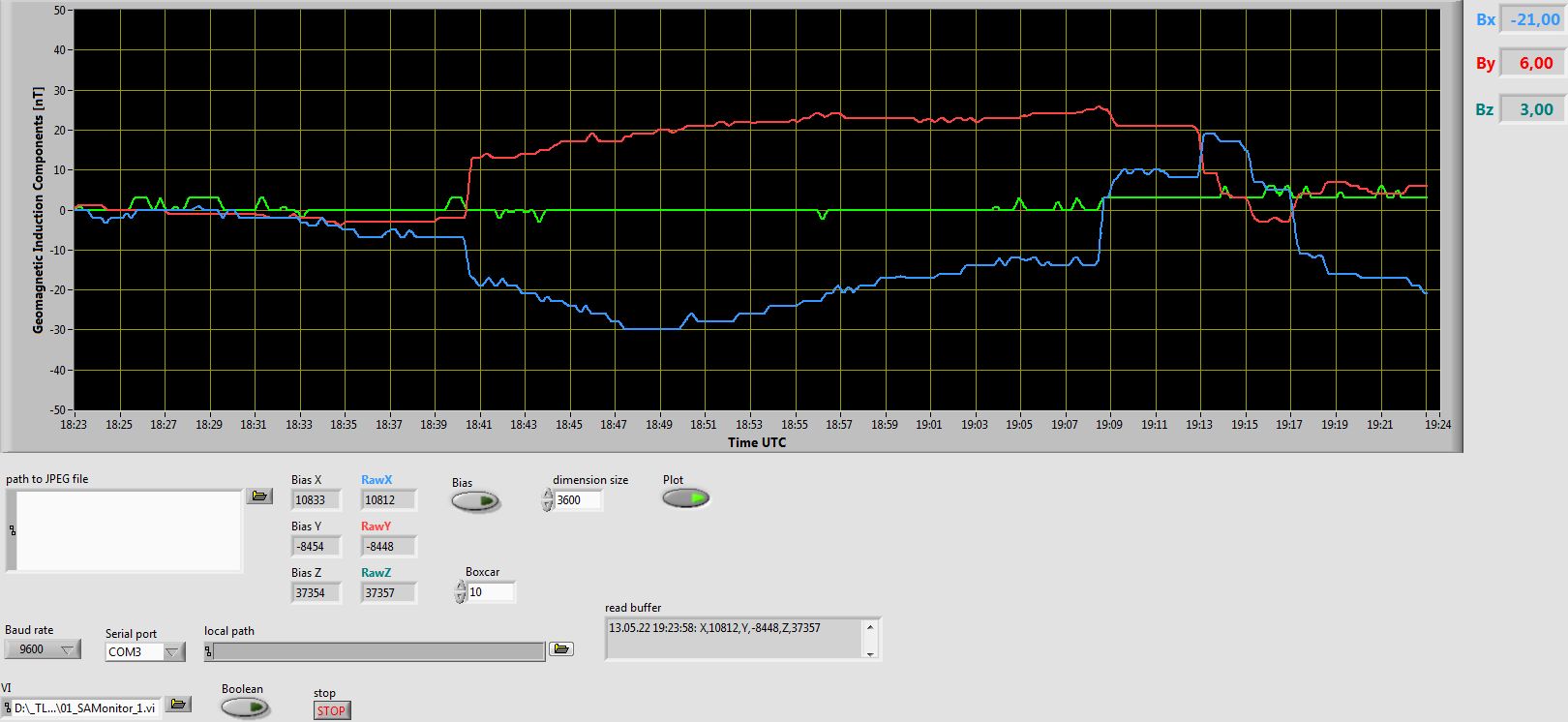
0016: 12. May 2022, 15:29,
#Geomagnetometer
I decided to take the SAM III geomagnetometer to
a presumably magnetically more quiet place in the
house. The picture shows the styrofoam thermal
insulation box. Thermal insulation is very important because the fluxgate
sensors are very temperature sensitive and the daily temperature pattern would
obscure weak to medium magnetic signals.
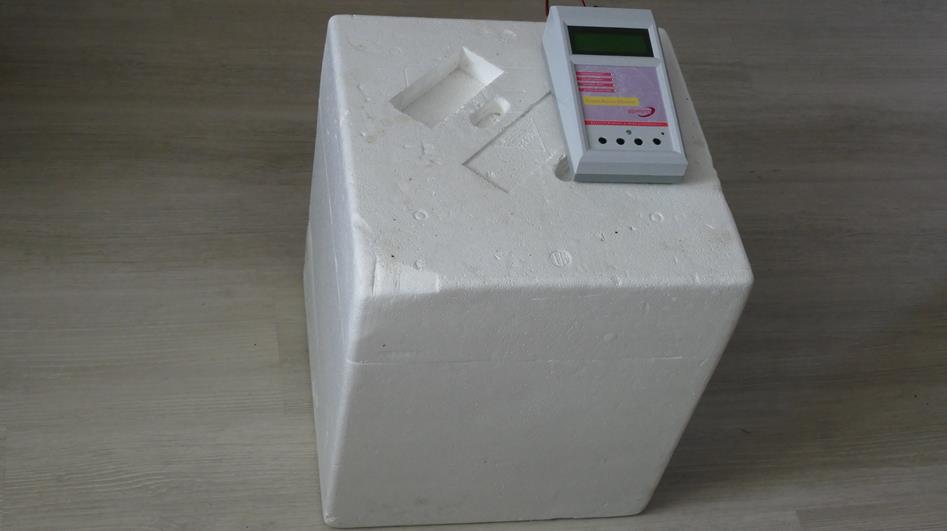
Here is the open box with some 20 kg of sand
inside. While the box alone reduces the thermal signal by a factor 4, the sand
load makes it practically disappear. The sand establishes a large heat
capacity. So the remaining thermal leak of the box
must warm/cool the sand.
The traditional way to
thermally insulate a geomagnetometer is to bury it in the garden. This
way there is a huge thermal load outside the box. In my approach
I put the thermal load inside the box. Now to see to what degree magnetic
disturbancies from inside the house will compromise the system. In case the
interference is too high I am still considering to
bury the box. Particularly for system testing it very convenient to have it in
house.

The sensor platform with three mutually
perpendicular fluxgate sensors. There is quite a load of sand under the
platform.
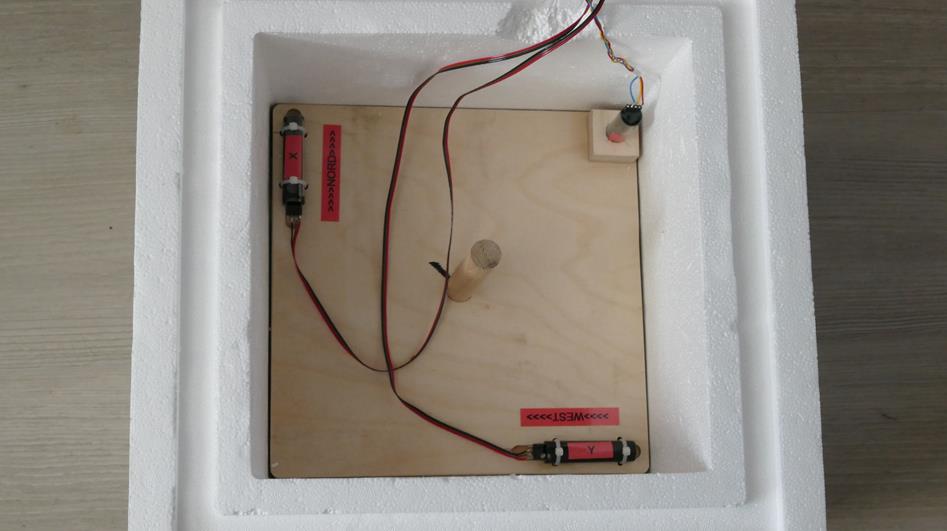
North alignment of the geomagnetometer. I am
aligning it to magnetic north instead of true north because any magnetic
aberration inside the house is unknown. Now to pack the sand in, put the lid on
and connect the controller.
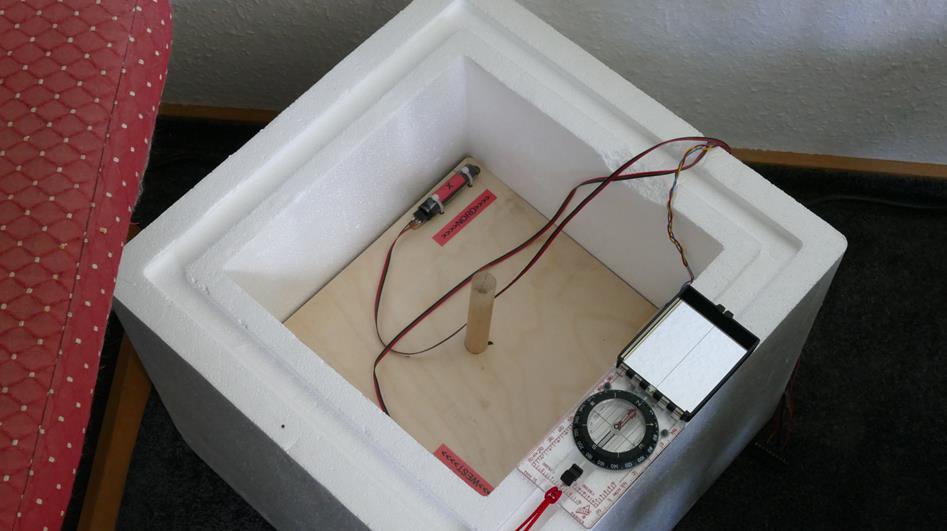
I am also putting together custom software for
the thing. It looks a little messy in the current debugging mode. When it is finished
it will be looking cleaner (are projects like this ever finished?) and it will
continuously record the geomagnetic field, archive data and upload a plot in 5
minute intervals to the website. Go ahead solar cycle
25!

0015: 09. May 2022, 14:00, #Equipment
My latest toy is a FLIR E60BX thermal camera. The
bright dot on top is today’s half moon. The camera measures about +20 °C on the
moon, but this is an average with a few pixels of cold sky around the moon. The
cold sky is -33 °C in the crosshair. Pointing to
zenith the temperature is below the camera’s lower limit of -40
°C.
The main application of this camera is examining
electronic circuitry for thermal issues.
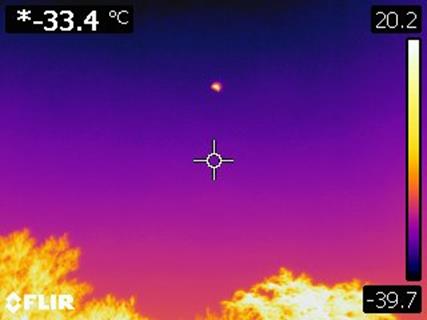
The camera takes a visual image together with
each thermal image. I find it quite remarkable that the moon shows a much
higher contrast in the thermal picture above.
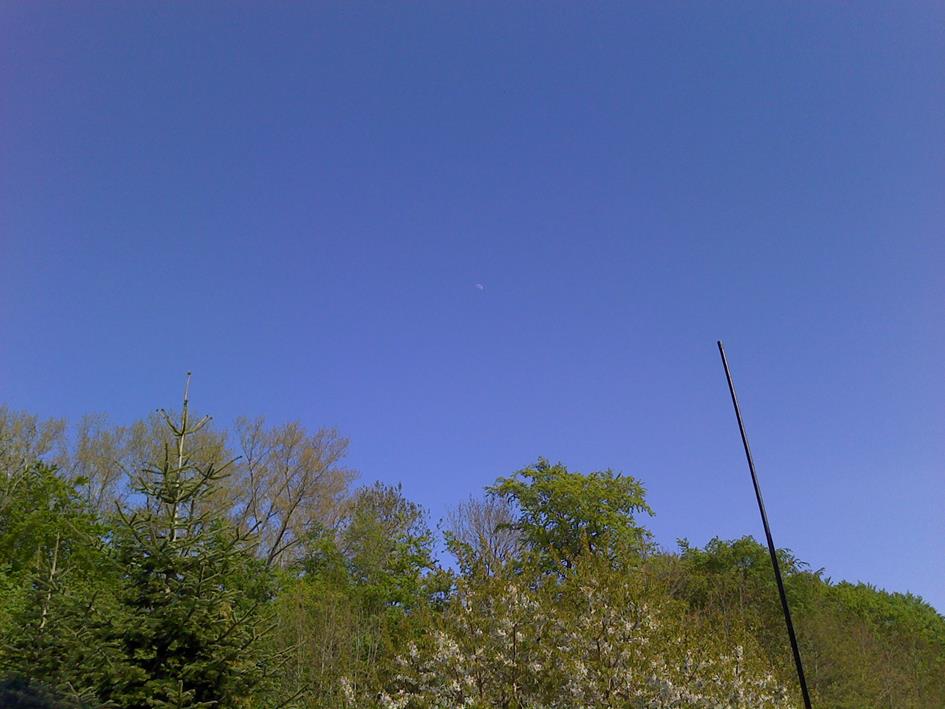
0014: 07. May 2022, 15:58, #Chang’e-5
Chang’e-5 must have been in a coherent
groundstation link. Telemetry sidebands are visible +/- 8 kHz from the carrier.
The signal showed slow intensity fluctuations after unlock. I hadn’t seen this in the current lunar orbit before. The
other frequency is weakly detectable too.
The antenna is pointing to Chang’e-5 after she
passed earth-moon Lagrange point 2 (EML2) and is moving further west.
0013: 03. May 2022, 20:27, #Chang’e-5
Chang’e-5 on her way to EML2 behind the moon.
The antenna is pointing to Chang’e-5 and a nice
young crescent moon.
0012: 2. May 2022, 09:15, #Tianwen-1
A very nice plot of Tianwen-1 showing the Doppler
maximum and minimum before and after the periapsis pass. The spacecraft was in
a groundstation lock during the maximum. It unlocked around 08:20 and showed an
unlocked minimum after periapsis.
From today’s and yesterday’s maxima, with 3
orbits in between, I calculate an orbital period of 7h 4min 49s, that is 11s
longer than the period I calculated a few months ago. However, there is some
uncertainty due to the coherent lock, which may add some phase shift to the
Doppler curve. Orbit determination can be more accurate from unlocked signals,
provided the spacecraft has a stable enough master oscillator. This seems to be
the case in Tianwen-1.
0011: 1. May 2022, 15:09, #Chang’e-5
Chang’e-5 this afternoon. She is heading to the far
side of the moon for an encounter with EML2. There is no groundstation activity
and we note the notorious frequency jitter of this signal. Frequency was compensated for eart rotation Doppler of my station.
0010: 1. May 2022, 11:15, #Tianwen-1
I caught a Doppler maximum of Tianwen-1 while it was locked to a groundstation, probably Zapala in Argentina.
Now to catch tomorrow’s maximum some 3 hours earlier in the day to calculate a
new orbital period.
0009: 30. April 2022, 14:00, #Tianwen-1
Tianwen-1 shows a strong signal. First unlocked
and at 08:48 it locks to a groundstation. Mars is not visible over China, so
Zapala in Argentina must be at the helm.
0008: 28. April 2022, 19:45, #Cat
It was about time to introduce fabulous Space Cat
to the new timeline.
0007: 28. April 2022, 14:44, #Chang’e-5
Chang’e-5 is passing the L1 libration point
between Moon and Earth. The signal on 8486.28 MHz is strong,
the other frequency 8471.23 MHz is no longer detectable for me. Earth rotation
Doppler compensation was activated at 13:12.
0006: 28.April 2022, 12:00, #MOM
No signal from MOM received this morning.
0005: 27. April 2022, 12:40, #Osiris-Rex
I caught Osiris-Rex’ signal while it was still
unlocked and showed some drift. It locked to Madrid’s DSS 54 at 11:04. Madrid
is obviously emitting Doppler compensated uplink,
otherwise we would see falling Doppler rate. At 12:35
the signal faded out for me. It came back for DSS 54, but some 35 dB weaker which is not detectable for me.
The NASA Eyes simulation shows the spacecraft
between the solar orbits of Mars and Earth. The current range rate to Earth is
some -10 km/s. The probe is expected to drop a
material sample it collected from asteroid Bennu in September 2023. Still some
way to the next Whiskey bar.
0004: 26. April 2022, 14:15, #BepiColombo
BepiColombo showed a strong x-band signal
coherently locked to Estrack Cebreros groundstation when I started observing at
12:42. It unlocked at 13:28 and the signal faded out after 14:00. I am not sure
why the signal faded away slowly. Typically spacecraft
just switch off. Maybe it was realigning with the high gain antenna still
transmitting.
The ESA simulation ( https://sci.esa.int/web/bepicolombo/-/48871-getting-to-mercury
) shows the spacecraft is currently quite close to Earth, only 48 million km
away. It is heading for another close encounter with Mercury,
I think it will be in July.
0003: 26. April 2022, 11:17, #Chang’e-5
Chang’e-5 on 8486.28 MHz. The other frequency is
detectable, but much weaker. Earth rotation Doppler compensation was activated
at 09:10. See Bill Gray’s https://projectpluto.com/sat_eph.htm
for ephemerides. Use NORAD number 47097 for Chang’e-5.
0002: 26. April 2022, 08:50, #MOM
Again
no signal from the Indian Mars orbiter MOM received this morning.
0001: 26. April 2022, 08:30
My antennas for deep space monitoring and the
VHF/UHF amateur radio bands.






















































